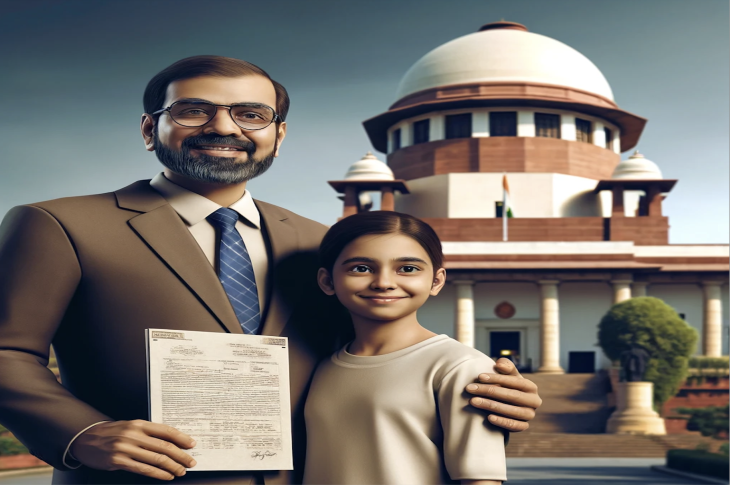Daughters' Right to Inherit Self-Acquired Property: Explaining Supreme Court Judgement
Introduction
In a significant judgment, the Supreme Court of India has upheld the right of daughters to inherit their father's self-acquired property, even if the father died before the enactment of the Hindu Succession Act, 1956. The case, Arunachala Gounder vs Ponnusamy and Others, involved a dispute over the inheritance of property belonging to one Marappa Gounder, who died in 1949, leaving behind his daughter Kupayee Ammal.
Background
Marappa Gounder, a Hindu male, died intestate in 1949, leaving behind his self-acquired property. His sole surviving daughter, Kupayee Ammal, inherited the property. However, upon her death in 1967, a dispute arose between Kupayee's legal heirs and the heirs of Marappa's brother's son, who claimed the property should devolve to them by survivorship.
The Trial Court and the High Court ruled against Kupayee's legal heirs, stating that the property should pass to Marappa's brother's son by survivorship. Aggrieved by this decision, Kupayee's heirs appealed to the Supreme Court.
The Supreme Court's Analysis
The Supreme Court delved into the intricacies of Hindu law to determine the rightful heirs to Marappa's self-acquired property. The Court examined ancient Hindu texts, commentaries, and judicial precedents to arrive at its decision.
1. The Right of Widows and Daughters to Inherit Self-Acquired Property
The Court cited the Mitakshara school of Hindu law, which recognized the right of widows and daughters to inherit a man's self-acquired property. The Mitakshara law also acknowledged inheritance by succession, not just survivorship, for self-acquired property.
2. Judicial Precedents Supporting Daughters' Inheritance Rights
The Supreme Court relied on several earlier judgments that upheld the rights of daughters to inherit their father's property. In Katama Natchiar vs The Rajah of Sivaganga (1863), the Privy Council held that a daughter could inherit her father's separate property in preference to collateral heirs.
Similarly, in Bhagat Ram (dead) by LRs. Vs. Teja Singh (dead) by LRs. (2002), the Supreme Court reiterated that the source from which a female inherits property is crucial in determining the succession.
3. The Impact of the Hindu Succession Act, 1956
The Court noted that since Kupayee Ammal died in 1967, after the enactment of the Hindu Succession Act, 1956, the provisions of this Act would govern the succession of her property. Under Section 14 of the Act, any property possessed by a female Hindu, whether acquired before or after the commencement of the Act, shall be held by her as a full owner and not as a limited owner.
Furthermore, under Section 15(1)(a) of the Act, the property of a female Hindu dying intestate would devolve upon her sons and daughters (including the children of any predeceased son or daughter) and her husband.
The Judgment
Based on its analysis, the Supreme Court held that since the property in question was the self-acquired property of Marappa Gounder, it would devolve by inheritance to his daughter Kupayee Ammal, despite the family being in a state of jointness. Upon Kupayee's death in 1967, her property would devolve upon her legal heirs under Section 15(1)(a) of the Hindu Succession Act.
The Court set aside the judgments of the Trial Court and the High Court and decreed the suit in favor of Kupayee's legal heirs.
Conclusion
The Supreme Court's judgment in Arunachala Gounder vs Ponnusamy and Others is a landmark decision that upholds the rights of daughters to inherit their father's self-acquired property, even if the father died before the Hindu Succession Act came into force. The judgment is a significant step towards gender equality in matters of inheritance and property rights.
By delving into the ancient texts and relying on judicial precedents, the Supreme Court has reaffirmed the position that daughters have an equal right to inherit their father's property, irrespective of whether the property was self-acquired or ancestral. This judgment is likely to have far-reaching consequences for Hindu families and will pave the way for a more equitable distribution of property between sons and daughters.
Read the judgment by downloading it from here:
Supreme Court Judement
Download JudgementFrequently asked questions
What was the main issue before the Supreme Court in the Arunachala Gounder vs Ponnusamy and Others case?
What was the main issue before the Supreme Court in the Arunachala Gounder vs Ponnusamy and Others case?
The main issue was whether the self-acquired property of a Hindu male who died intestate before the Hindu Succession Act, 1956, would devolve by inheritance to his daughter or by survivorship to his brother's son.
What were the key arguments made by the parties in the case?
What were the key arguments made by the parties in the case?
The legal heirs of the deceased's daughter, Kupayee Ammal, argued that she had inherited the property from her father and that they were entitled to the property as her heirs. On the other hand, the brother's son claimed that the property should devolve to him by survivorship, as the family was in a state of jointness.
What were the main provisions of the Hindu Succession Act, 1956, that the Supreme Court relied upon in its judgment?
What were the main provisions of the Hindu Succession Act, 1956, that the Supreme Court relied upon in its judgment?
The Court relied on Section 14 of the Act, which states that any property possessed by a female Hindu, whether acquired before or after the commencement of the Act, shall be held by her as a full owner and not as a limited owner. The Court also relied on Section 15(1)(a), which provides that the property of a female Hindu dying intestate would devolve upon her sons and daughters (including the children of any predeceased son or daughter) and her husband.
How did the Supreme Court interpret the ancient Hindu texts and commentaries in arriving at its decision?
How did the Supreme Court interpret the ancient Hindu texts and commentaries in arriving at its decision?
The Supreme Court extensively examined the Mitakshara school of Hindu law and various ancient texts and commentaries. It noted that these sources recognized the right of widows and daughters to inherit a man's self-acquired property and that inheritance by succession was acknowledged for self-acquired property, not just survivorship.
What is the significance of the Supreme Court's judgment in this case?
What is the significance of the Supreme Court's judgment in this case?
The judgment is a landmark decision that upholds the rights of daughters to inherit their father's self-acquired property, even if the father died before the Hindu Succession Act came into force. It reaffirms the position that daughters have an equal right to inherit their father's property, irrespective of whether the property was self-acquired or ancestral. The judgment is a significant step towards gender equality in matters of inheritance and property rights and is likely to have far-reaching consequences for Hindu families.
Trending
Frequently asked questions
What was the main issue before the Supreme Court in the Arunachala Gounder vs Ponnusamy and Others case?
What was the main issue before the Supreme Court in the Arunachala Gounder vs Ponnusamy and Others case?
The main issue was whether the self-acquired property of a Hindu male who died intestate before the Hindu Succession Act, 1956, would devolve by inheritance to his daughter or by survivorship to his brother's son.
What were the key arguments made by the parties in the case?
What were the key arguments made by the parties in the case?
The legal heirs of the deceased's daughter, Kupayee Ammal, argued that she had inherited the property from her father and that they were entitled to the property as her heirs. On the other hand, the brother's son claimed that the property should devolve to him by survivorship, as the family was in a state of jointness.
What were the main provisions of the Hindu Succession Act, 1956, that the Supreme Court relied upon in its judgment?
What were the main provisions of the Hindu Succession Act, 1956, that the Supreme Court relied upon in its judgment?
The Court relied on Section 14 of the Act, which states that any property possessed by a female Hindu, whether acquired before or after the commencement of the Act, shall be held by her as a full owner and not as a limited owner. The Court also relied on Section 15(1)(a), which provides that the property of a female Hindu dying intestate would devolve upon her sons and daughters (including the children of any predeceased son or daughter) and her husband.
How did the Supreme Court interpret the ancient Hindu texts and commentaries in arriving at its decision?
How did the Supreme Court interpret the ancient Hindu texts and commentaries in arriving at its decision?
The Supreme Court extensively examined the Mitakshara school of Hindu law and various ancient texts and commentaries. It noted that these sources recognized the right of widows and daughters to inherit a man's self-acquired property and that inheritance by succession was acknowledged for self-acquired property, not just survivorship.
What is the significance of the Supreme Court's judgment in this case?
What is the significance of the Supreme Court's judgment in this case?
The judgment is a landmark decision that upholds the rights of daughters to inherit their father's self-acquired property, even if the father died before the Hindu Succession Act came into force. It reaffirms the position that daughters have an equal right to inherit their father's property, irrespective of whether the property was self-acquired or ancestral. The judgment is a significant step towards gender equality in matters of inheritance and property rights and is likely to have far-reaching consequences for Hindu families.



Ask a Lawyer